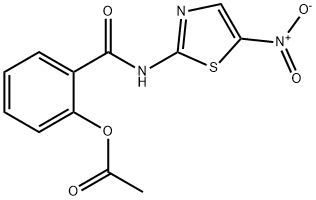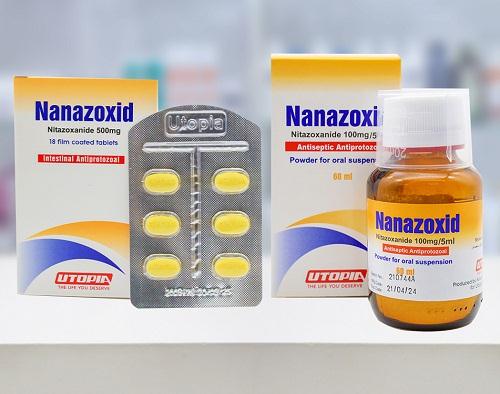Nitazoxanide: A Versatile Pharmacological Agent
General description
Nitazoxanide, a broad-spectrum antiparasitic and antiviral medication, has emerged as a significant pharmaceutical agent since its approval in the early 2000s. Primarily known for its effectiveness against a wide range of parasitic infections, its application has expanded to include the management of various viral diseases, showcasing its versatility in the pharmaceutical field.
Synthesis

Fig. 1 The synthesis route of Nitazoxanide
Add pyridine (1.2 mmol) to a stirred solution of a protected salicylic acid (1 mmol) in dry Et2O (10 mL) at 0 °C. Add thionyl chloride (1.2 mmol) dropwise to the reaction mixture. Continue stirring at 0 °C for 4 hours. Filter the white precipitate. Concentrate the white precipitate under a vacuum. Use the free amine directly or the HCl salt of the 2-aminothiazole.Partition the reaction between dilute aqueous NaOH and EtOAc.Separate the organic layer. Dry the organic layer. Evaporate the organic layer to dryness. Add Et3N (1 equivalent) a solution of the thiazole (1 mmol) in THF (3 mL) to a stirred solution of salicyloyl chloride (1 equivalent) in THF (3 mL/mmol) at 0 °C. Stir the solution at room temperature, until the reaction. Pour the reaction mixture into the water. Extract the reaction mixture with ethyl acetate (2×). Wash the organic layer with 1M HCl and water. Dry the organic layer. Evaporate the organic layer. Purify the product by column chromatography. The synthesis route is shown in Fig. 1[1].
Pharmacological Background
Nitazoxanide, a thiazolide compound, stands out in the pharmacological landscape due to its unique chemical structure and broad-spectrum activity. It is synthesized from 5-nitrothiazole, which forms the backbone of its antiparasitic and antiviral properties. Classified under the antiparasitic agents, Nitazoxanide's versatility extends beyond this category, engaging with a variety of cellular targets across different organisms.
The drug is well-absorbed orally, undergoing rapid hydrolysis in the liver to its active metabolite, tizoxanide, which circulates predominantly bound to plasma proteins. This process ensures a widespread distribution throughout the body, enabling Nitazoxanide to reach and exert its effects on intracellular pathogens efficiently.
Mechanism of Action
Nitazoxanide operates through a multifaceted mechanism of action, distinguishing it from many other antiparasitic and antiviral drugs. Its ability to inhibit a wide range of pathogens stems from its interference with the pyruvate ferredoxin oxidoreductase (PFOR) enzyme-dependent electron transfer reaction, which is crucial for anaerobic energy metabolism in parasites. By disrupting this process, Nitazoxanide effectively hampers the growth and survival of protozoa and helminths.
In the realm of antiviral activity, Nitazoxanide has been shown to block the replication of various viruses, including influenza, hepatitis B and C, and norovirus, among others. It achieves this by impairing the maturation of viral particles, a mechanism that is not fully understood but is thought to involve the inhibition of the viral N-linked glycosylation process. This broad-spectrum activity highlights its potential as a versatile tool in the fight against infectious diseases.
Moreover, recent studies suggest that Nitazoxanide may modulate the host immune response, enhancing the body's ability to combat infections. This immunomodulatory effect, coupled with its direct action on pathogens, makes Nitazoxanide a unique and valuable agent in infectious disease pharmacotherapy[2].
Safety and Side Effects
The safety profile of Nitazoxanide is generally favorable, with most adverse effects being mild and transient. Common side effects include abdominal pain, nausea, vomiting, and diarrhea, which are typical of many oral antiparasitic agents. These symptoms usually resolve without the need for discontinuation of therapy, making Nitazoxanide a well-tolerated option for many patients.
Rarely, more serious side effects such as neutropenia, and a decrease in the number of white blood cells, have been reported, emphasizing the need for monitoring in patients with underlying health conditions. However, such occurrences are infrequent, and the overall risk-benefit ratio of Nitazoxanide remains positive[3].
In terms of drug interactions, Nitazoxanide has a low potential for significant pharmacokinetic interactions, as it does not significantly affect the cytochrome P450 enzyme system. This characteristic further enhances its safety profile, making it a suitable choice for patients on multiple medications.
References
[1]Stachulski, Andrew V.; et al.Thiazolides as Novel Antiviral Agents. 1. Inhibition of Hepatitis B Virus Replication.
Journal of Medicinal Chemistry (2011), 54(12), 4119-4132.
[2]Anderson V R, Curran M P. Nitazoxanide: a review of its use in the treatment of gastrointestinal infections[J]. Drugs, 2007, 67: 1947-1967.
[3] White Jr A C. Nitazoxanide: a new broad-spectrum antiparasitic agent[J]. Expert review of anti-infective therapy, 2004, 2(1): 43-49.
You may like
Related articles And Qustion
See also
Lastest Price from Nitazoxanide manufacturers

US $0.00/KG2025-09-26
- CAS:
- 55981-09-4
- Min. Order:
- 1KG
- Purity:
- ≥99.9%(HPLC)
- Supply Ability:
- 10000KGS

US $5.00-0.50/KG2025-06-13
- CAS:
- 55981-09-4
- Min. Order:
- 0.10000000149011612KG
- Purity:
- 99% hplc
- Supply Ability:
- 5000kg



